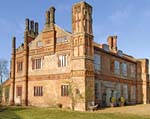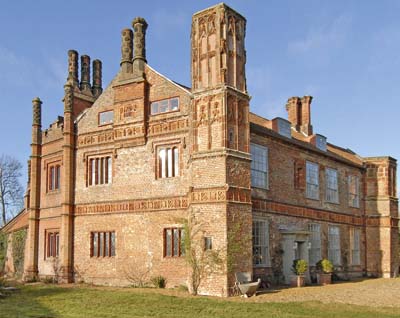The country house market in 2012
Great expectations have been realised this year in the country-house market, withstar properties being snapped up within days and persistence finally paying off


In a year that was all about winners, only the best was ever likely to be good enough in an increasingly polarized country-house market. North Norfolk in winter seemed an unlikely backdrop to success when, on February 15, Nigel Steele of Jackson-Stops & Staff in Norwich launched The Manor House at Great Snoring, near Fakenham, on the market in Country Life at a guide price of £1.8 million.
A deal was agreed 11 days later, on February 26. Even by Norfolk's quirkiest standards, there was nothing run-of-the-mill about the historic, 15th-century former rectory, listed Grade II*, which was built by Sir Ralph Shelton between 1470 and 1490 as a hexagon with turrets at each corner, and decorated with complex terracotta work, similar to that seen at East Barsham Manor, another house with Shelton family connections.
In 1611, another Sir Ralph Shelton sold the manor declaring that he could ‘sleep without Snoring', after which the house became a rectory, continuing as such until the 1960s, when it was sold by the Church. It later became a hotel, before reverting to its original role as a private family house. There was no snoring, and not much sleep either, for the team at Surrey-based developersOctagon before the launch, in March, of the firm's latest trophy mansion, Upper Ribsden at Windlesham, Surrey, at a guide price of ‘excess £25m', through Knight Frank.
The spectacular, 27,000sq ft house, set in six acres of landscaped grounds amid the pinewoods surrounding Sunningdale golfcourse, had taken five painstaking years to build. It was the company's most ambitious project to date, aimed squarely at the wealthy international buyers who continue to dominate the top end of the residential market in London, Berkshire and Surrey.
Planning restrictions on height meant digging out a massive basement and Mediterraneanstyle courtyard at the rear of the building, a hugely complex and expensive process that provided room for a 13m (43ft) swimming pool, a games and leisure suite, a cinema, an industrial-style catering unit and wine cellar, staff quarters and an underground garage for six limousines. Inside the main house, extensive use of marble, glass and mirrors created an overwhelming impression of light, space and opulence throughout its five reception rooms, six bedroom suites and impressive entertaining spaces. A four-bedroom staff cottage and thoughtfully planted gardens and grounds completed a picture of restrained but total luxury. The concept hit all the right notes and, before long, Knight Frank had organised the sale of Upper Ribsden to an international buyer for a cool £30m. ‘This has been an exceptional, even extraordinary, year for us,' says Octagon's dynamic CEO, Colin Tutt. ‘We've broken our sales-price records several times over and, having sold the Windlesham mansion, went on to achieve the highest value recorded in Roehampton's premier road, Roedean Crescent, when Roedean House sold for £6.5m.' Out in the country, a long war of attrition came to a triumphant end when, in April, Knight Frank and Savills finally exchanged contracts on the peerless Pusey House and estate in Oxfordshire at a price reported to be around £30m-making it the most valuable estate sale of the year, at least on the open market.
The classic, 643-acre estate with its grand, Grade II*- listed Georgian house, stable courtyard, cottages, woodland and sporting facilities, 13 miles fromOxford, was launched in Country Life on June 30, 2010, at a guide price of £23m, a figure that was eventually surpassed when several ‘triple A' applicants locked horns earlier this year.
Highlighting the general ‘flight to quality' at the top end of the country-house market, Jonathan Bramwell of The Buying Solution saw little activity in the Cotswolds in the £3m to £5m price range, although the market for properties valued at more than £5m showed a marked improvement, with 11 sales recorded at £5m-plus, compared to seven in 2011. ‘Interestingly, six of those achieved in 2011 were below £10m, whereas this year, we've seen three sales of £10m to £20m, and one estate of more than £20m. Six of these were in the Oxford to Chipping Norton/ Stow-on-the-Wold area, of which half were school-related,' says Mr Bramwell. The guide price of ‘excess £8m' quoted by Knight Frank for the exquisite, Grade II*- listed Broadwell Manor at Broadwell, near Stow-onthe- Wold, Gloucestershire, was thought by some to be a financial step too far in the current market, when it launched in the May 2 number of Country Life. But being precisely the kind of good family house that has been conspicuously lacking inthese parts in recent years, the historic, 13,100sq ft, eightbedroom manor house, set in 35 acres of landscaped gardens and paddocks, attracted a flood of interest, and quickly soldfor more than the guide price, with contracts exchanged by the end of June. The architects and stonemasons who created Oxford's ‘dreaming spires' also brought a touch of their magic to the villages roundabout. The June 13 number of Country Life saw the launch onto the market of the incomparable, Grade II*- listed Garsington Manor, which sits high on a hill on the southern edge of Garsington village in Oxfordshire, looking south-west across the Thame valley to the Chilterns.
Exquisite houses, the beauty of Nature, and how to get the most from your life, straight to your inbox.

The £6.5m guide price quoted by Carter Jonas was no deterrent to the many prospective purchasers from the UK and overseas, who flocked to view the charming Jacobean manor set in 11 acres of enchanting gardens, described by historian Jeremy Musson (Country Life, June 26, 1997), as ‘one of the most charming smaller manor houses in England'. Although perhaps better known to today's Country Life readers as the setting for the Garsington summer opera festival founded by banker Leonard Ingrams and his wife, Rosalind, who bought the house in 1982, Garsington Manor eventually sold in November for more than its original guide price.
‘After five years of recession, the country-house market in Devon is finally learning to live without banks,' says Martin Lamb of Savills in Exeter, although his colleague Richard Addington thinks a further 20% devaluation of prices is needed to kick-start a real recovery. But patience and forbearance paid off for Savills when a buyer was signed up in June for the dreamy Gullet estate at South Pool, near Salcombe.Launched in Country Life in September 2011 at a guide price of ‘excess £10m', the secluded, 155-acre estate is arguably the most important property on the Salcombe estuary, with 11⁄2 miles of water frontage, a 9,000sq ft Arts-and-Crafts house, a boat house, six cottages and 35 acres of foreshore.
Reflecting the harsh reality of the marketplace, it hadbeen offered earlier this year with less land at a substantially lower guide price, but, happily, the new owners decided to buy the entire estate at itsoriginal guide price, and are now embarking on a major project to improve the house and its idyllic landscape. September is a golden time in rural Wiltshire, and never more so than this year, when the autumn campaign kicked off with the launch of Capt Fred Barker's enchanting, 729-acre Lushill estate between Hannington and Castle Eaton on the Wiltshire-Gloucestershire borders, at a guide price of‘excess £12m' through Strutt & Parker.
In these difficult times, it's not often that the relationship between vendor and estate agent can be dubbed ‘a marriage made in heaven', but the sale of Lushill-which raced to exchange of contracts within six weeks-appears to have been conductedthroughout in perfect harmony. The heart of the estate is the charming, neo-Georgian Lushill House, created by Capt Barkerin 1965 around the ruins of a derelict former mansion. The architect Thomas Bird was commissioned to design and build the new house, incorporating significant elements of the old the interiors were the work of the postwar prince of decorators, John Fowler. In a touching postscript to the story, Capt Barker was surprised to receive a visit from Thomas Bird, now aged 92, who had read of the impending sale in Country Life and decided to see for himself how his work had turned out: ‘He spent two hours walking around, checking everything-doors, walls, windows, dado-rails and so on- and was delighted to find that nothing had moved in the 50 years since it was built. Needless to say, so was I,' the happy vendor added.
Country Life is unlike any other magazine: the only glossy weekly on the newsstand and the only magazine that has been guest-edited by His Majesty The King not once, but twice. It is a celebration of modern rural life and all its diverse joys and pleasures — that was first published in Queen Victoria's Diamond Jubilee year. Our eclectic mixture of witty and informative content — from the most up-to-date property news and commentary and a coveted glimpse inside some of the UK's best houses and gardens, to gardening, the arts and interior design, written by experts in their field — still cannot be found in print or online, anywhere else.

